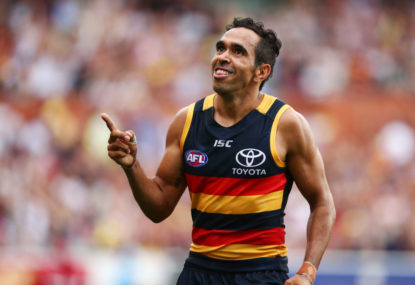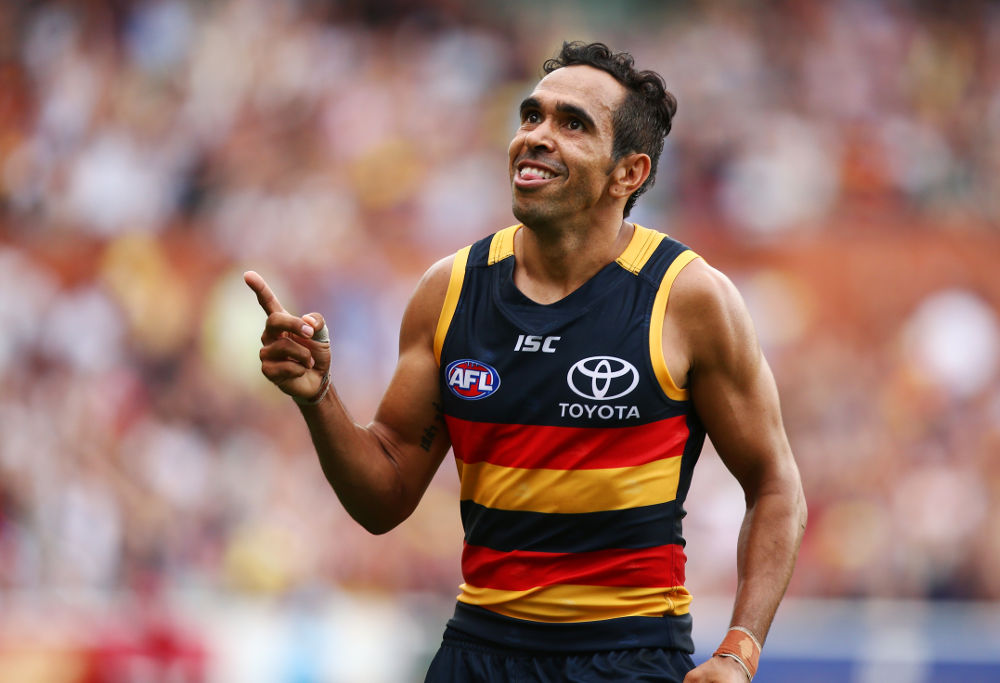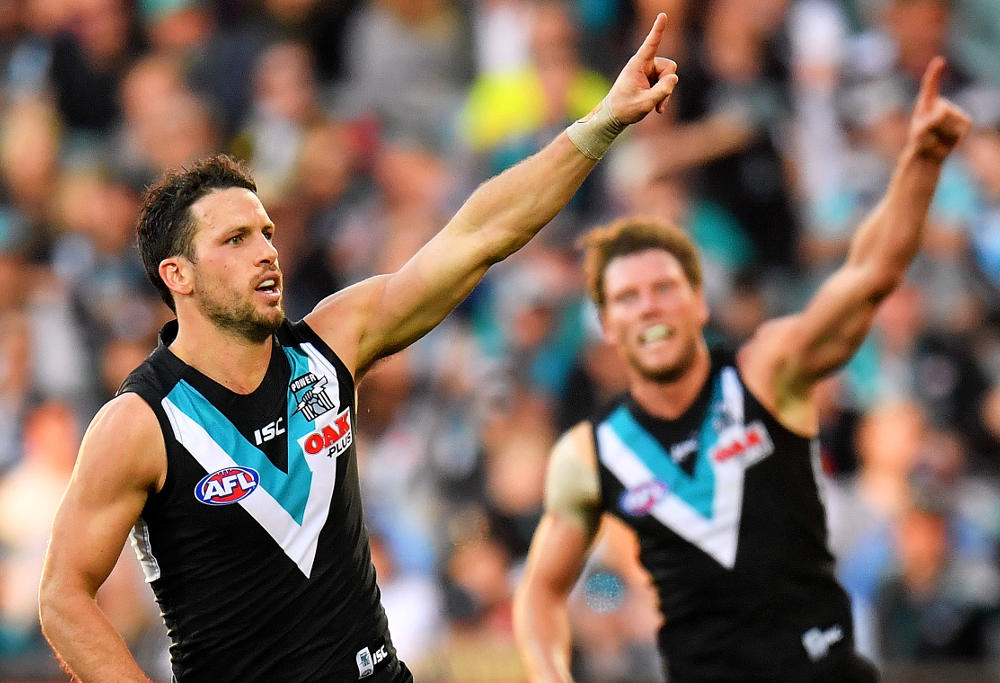The crucial cogs of AFL's Round 7: Which players need to be the difference makers?
We’re taking a look at one player from each team that needs to make a difference this week, starting with the ANZAC Day games.

At the beginning of the season, I wrote an article analysing the size of our playoff structure, in comparison to major sports around the globe.
I unilaterally declared that eight out of eighteen was the perfect number for finals, and the double chance formula provided advantages for achieving top two, top four, and top six as well as the final eight.
(We also came to the conclusion that for an eight-team AFLW league, three teams with a bye for the top seed was the best structure. But that’s another story.)
Now that we’ve reached those finals, let’s look at the ELO-Following Football ratings for the eight remaining teams, and make some projections for the finals.
The ELO rating system was devised by a Hungarian-American physics professor named Arpad Elo, who was an active participant in the founding of the United States Chess Federation in 1939. He devised this relatively simple mathematical system which compared the relative abilities of the two competitors (in the form of a number, called their ‘rating’) and adjusted those ratings up or down depending on the result of their game.
If the higher-rated competitor won, as expected, they would gain relatively few points and their opponent would lose the same small number of points. On the other hand, if the lower-rated competitor upset their opponent, they would gain a much larger number of points (and their opponent would lose the same number of points).
Even a draw affects the ratings: the lower-rated competitor would gain a few points, having performed better than expected. (The opposite would happen for their opponent.)
This system is still in place in chess, eight decades later, and has been applied to sports all across the world. (In fact, ESPN has a competing system for the AFL, if you’re interested.) The ‘Following Football’ ELO rating system is used for not just the AFL but Canadian football, the NFL, and the top levels of American college football.
For the AFL, we use 50 as the mean, meaning that the average rating of the 18 teams at any moment is always 50. Without further ado, here are the ten teams who missed finals in 2017:
Brisbane Lions: 18th place, 5-17. Final rating: 21.7 (16th place).
Started at 9.5, bottomed out at 4.4 in Round 9, topped out at 28.8 in Round 22.
Gold Coast Suns: 17th place, 6-16. Final rating: 7.8 (18th place).
Started at 32.0, topped out at 41.4 in Round 7, bottomed out at 7.8 in Round 23.
Carlton Blues: 16th place, 6-16. Final Rating: 31.5 (15th place).
Started at 31.9, bottomed out at 21.1 in round 5, topped out at 40.2 in Round 16.
North Melbourne Kangaroos: 15th place, 6-16. Final rating: 36.1 (14th place).
Started at 51.0, topped out at 57.5 in Round 7, bottomed out at 29.0 in Round 22.
Fremantle Dockers: 14th place, 8-14, Final rating: 18.1 (17th place).
Started at 29.0, topped out at 41.5 in Round 9, bottomed out at 14.6 in Round 22.
Collingwood Magpies: 13th place, 9-12-1. Final rating: 51.7 (8th place!)
Started at 54.7, topped out at 56.0 in Round 6, bottomed out at 40.8 in Round 16.
Hawthorn Hawks: 12th place, 10-11-1. Final rating: 50.6 (9th place).
Started at 57.2, bottomed out at 26.6 in Round 6, reached 56.5 in Round 19.
St Kilda Saints: 11th place, 11-11. Final Rating: 50.1 (10th place).
Started at 49.2, bottomed out at 44.3 after Round 1, topped out at 62.6 after round 7.
Western Bulldogs: 10th place, 11-11. Final rating: 44.6 (13th place).
Started at 69.6, topped out at 72.2 after Round 2, bottomed out at 42.9 in Round 16.
Melbourne Demons: ninth place, 12-10. Final rating: 50.1 (11th place).
Started at 43.8, bottomed out at 43.4 in round 5, topped out at 62.1 in Round 13.
So, seven of the finalists make up the top seven ELO-FF rated teams, with Essendon the lone exception. (Make what you will of Collingwood having such a high rating and still landing in 13th place this season. They did have the second-highest percentage of the non-finalists at 99 per cent.)
Here are the match-ups during the first week of finals:
Thursday: GWS versus Adelaide, qualifying final
Adelaide Crows: first place, 15-6-1. Final rating: 79.4 (second place).
Started at 73.5, peaked at 90.0 in Round 6, dropped to 67.7 by Round 8, rose into the high 70s but bottomed out at 68.3 in Round 16, and reached as high as 84.3 in Round 21.

(Photo by Morne de Klerk/Getty Images)
Greater Western Sydney Giants: fourth place, 14-6-2. Final rating: 59.8 (6th place).
Started at 75.8, rose to 84.8 by round 5, and between then and Round 19’s nadir of 54.6, had only one game where their rating didn’t drop. Rose to 64.7 by Round 22.
According to the ratings, adding six for the home field advantage, Adelaide is favoured by 25.6 points. As of Sunday night, the spread is 13.5 in the Crows’ favour. Personally, I’d split the difference and take the Crows at 19 points or so.
Friday: Richmond versus Geelong, qualifying final
Geelong Cats: second place, 15-6-1. Final rating: 68.4 (4th place).
Started at 67.8 and stayed fairly close to that all season. Hit a high of 77.3 in round 5, and a low of 54.8 after Round 8, and then stayed within a twelve point range topping out at 68 from then on.
Richmond Tigers: third place, 15-7. Final rating: 69.3 (3rd place).
Started at 34.0, believe it or not! (Remember, we were discussing Damien Hardwick’s job security five months ago?) Hit 50 in Round 4, crossed the mid-line for good after Round 10. The big victory in Round 22 propelled them into the 60s, and they finished with their highest rating of the year.
According to the ratings, Geelong is only favoured because they’re at home. If you count the MCG as a neutral site (which is my opinion: Geelong fans will predominate, but Richmond knows the ground better), then Richmond should be 0.9 point favourites. (If you want to argue a home field advantage for Geelong, then they end up being slight favourites.) Betting companies have the Cats as 4.5 point favourites, and with Joel Selwood back in the line-up, I think that’s about right.
Saturday afternoon: Essendon versus Sydney, elimination final
Sydney Swans: sixth place, 14-8. Final rating: 89.3 (1st place).
Started at 80.5, the highest in the comp. Dipped all the way to 52.3 after round 6, and climbed in all but three of the remaining 16 games to their present rating, their peak this year.
Essendon Bombers: seventh place, 12-10. Final rating: 48.3 (12th place).
After their spoon last year, they started this year at their lowest point, 22.1. Their high point was 62.3 in Round 17, before fading and dropping rating points in five of their last six.
The ELO-FF ratings suggest a rout: with the SCG home advantage added in, Sydney is favoured by a whopping 47 points. The bookies’ average is slightly more conservative, suggesting a 31.5 point spread. I tend to believe my numbers this time – if the Dons don’t put on the game of their lives, this will be at least an eight-goal margin.
Saturday evening) West Coast at Port Adelaide, elimination final
Port Adelaide Power: fifth place, 14-8. Final rating: 67.4 (5th place).
Started at 53.7, rapidly rose to their peak of 76.9 in round 8. Since then, Port has bounced from the low 50s to the mid 70s, ending at 67.4.
West Coast Eagles: eighth place, 12-10. Final rating: 55.8 (7th place).
Started at 62.7. Hit 67.5 after one game, and never reached that rating again. But the only time they fell below the midline of 50 was at their bye week, during Round 12, at 49.9.
The ratings suggest that the Power should win by 17.6 points. The bookies say it’ll be 13.5 points, and I’d suggest that’s not a bad range to work from – two or three goals Port’s way.

(Photo by Daniel Kalisz/Getty Images)
If those predictions hold, week two will feature Sydney travelling to the MCG to take on the loser of the Geelong/Richmond game, while Port Adelaide will presumably travel to Sydney to play GWS. Ratings favour the two road teams, which would put Sydney in Adelaide for the prelim final. The Power will go to whichever Victorian team has only played once in the last three weeks (I say Geelong) – which should favour the home team, despite the evidence from last year.
Sydney’s ten-point rating advantage should theoretically get them past the Crows as well as Geelong or whomever comes out of the other side of the bracket. But then again, they were twenty-plus point favourites over the Bulldogs last year – and there could be a Bulldog story lurking in the mist for us to thrive on in 2017.
Who knows? That’s the beauty of the game – this rating system predicted more games correctly than the oddsmakers did (127 to 125), but out of 198 games, that still means there’s a ⅓ chance of an upset every time out! If we can have five straight weeks where the #17 team on the ladder upset their opponent, any of the top eight can win any game they play – so sit back and enjoy!